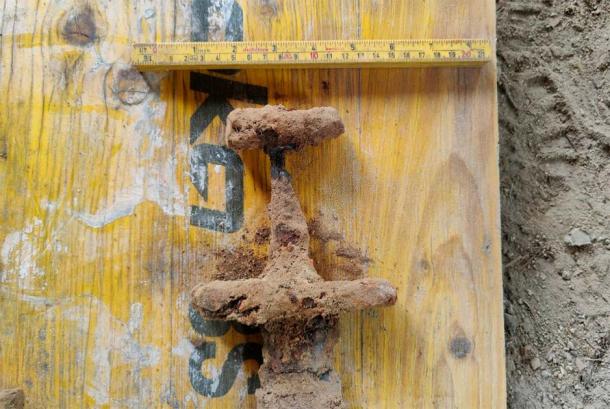Viking Burial, Sword, and Treasure Unearthed During Home Remodeling Excavation
Little did Oddbjørn Holum Heiland know what he would find when he embarked on a Friday night project, commencing excavation work behind his 1740 Setesdalshouse alongside his wife, Anne.
Long story short, the oblong top of a gravestone and the iron hilt of a sword, both related to the Viking Age, were discovered! The full significance of the discovery? A stunning Viking burial site that was completely unexplored.
Their plan was to extend the house, creating additional space in the rear. Speaking to Science in Norway over the phone from Setesdal in Southern Norway, Heiland mentioned, “I initially intended to do just a small amount of digging on the slope behind the house, to create some distance between the house and the surrounding land.” But what a can of worms was opened!
A Grave and a Sword: Surprising Finds
As Heiland removed the grass and topsoil, an oblong stone came into view. Paying little attention to it, he set it aside and continued digging. However, as the digging bucket penetrated the next layer—the moraine beneath the topsoil—a surprising iron object emerged.
Heiland recounted, “I looked at it and thought, ‘This looks a lot like a sword blade .’ And when I emptied the contents of the digging bucket, the hilt of a sword fell out.”

Suddenly, it dawned on Oddbjørn that the stone he had just uncovered might be a gravestone. Curiosity led him to conduct a brief online search, where he stumbled upon an almost identical sword from the Viking Age discovered in another region of the country some time ago. “That’s when I realized that this must be Viking-related,” he admitted.
Demonstrating commendable responsibility, Oddbjørn promptly ceased his excavation activities, safely stored the unearthed items, and wasted no time in contacting the county municipality on Monday morning.
In a swift response, county archaeologist Joakim Wintervoll from Agder County municipality and Jo-Simon Frøshaug Stokke from the Museum of Cultural History in Oslo arrived the following day to examine the remarkable find – it was their assessment that confirmed the profundity of the find.

The sword’s construction provides archaeologists with valuable insights for dating the discovery. Comprising two sword fragments, the recovered pieces form a sword measuring 70 cm (27.5 in) in length, with a blade width of 5 cm (1.96 in) at its widest point.
The hilt, an item influenced by fashion trends, exhibits a style that places it around the late 800s to early 900s, reports Arkeonews.
Previous Digs and Other Finds at the Site
Oddbjørn and Anne Holum Heiland had sought approval for their house extension, considering they reside in a historical dwelling dating back to 1740. “Given the distance from other cultural heritage sites,” Wintervoll remarks, “we did not anticipate the likelihood of finding anything significant in that particular area.”
Furthermore, Anne’s parents had conducted excavations around the house in the 1970s. Thus, it appears purely coincidental that the grave site had remained undisturbed until now.
In addition to the sword and potential gravestone, the Setesdal grave yielded a lance—a long spear designed for mounted warfare. However, as of now, no further indications suggest that this is the burial site of a mounted warrior.

Other remarkable items discovered include gilded glass beads and a belt buckle . Notably, while placing the buckle in the designated museum box, a glimmer of gold caught their attention, leading to the belief that the buckle itself might be gilded. Lastly, a bronze brooch, featuring a typical Viking animal motif, was also found. These brooches were commonly used to fasten capes securely in place.
Gender and Age: Challenges and Politics of Viking Burials
Stokke further explains that collection of weapons and jewelry suggest it’s a site rather than a grave. Very few Vikings were wealthy enough to afford extravagant possessions like helmets and swords, despite what popular historical sentiment about them might feel like. This particular grave was clearly that of a person from a higher social status, with access to resources.
The jewelry was an indicator that the grave was that of a man, not a woman. Men appreciated luxurious possessions and it was not uncommon for men’s graves to yield jewelry.
As of now, it is difficult to indicate the gender and age of the deceased person’s age, due to decomposition of bones and other organic matter.
